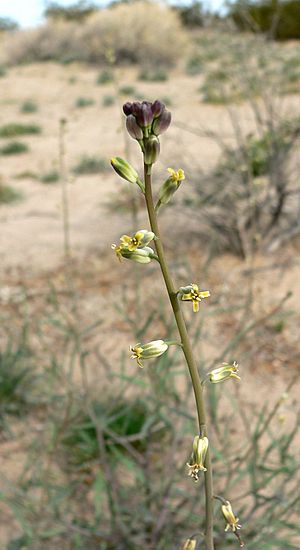Longbeak streptanthella facts for kids
Quick facts for kids Longbeak streptanthella |
|
|---|---|
 |
|
| Scientific classification | |
| Genus: |
Streptanthella
|
| Species: |
longirostris
|
Streptanthella longirostris, also known as longbeak streptanthella, is a type of flowering plant. It is the only species in its group, called a monotypic genus, named Streptanthella. This plant belongs to the Brassicaceae family, which is also known as the mustard family.
You can find Streptanthella longirostris growing naturally in western North America. This includes many parts of the western United States and the northwestern areas of Mexico. It is a tough plant that can grow in many different places. These include deserts, areas with sagebrush, woodlands at the bottom of hills, sandy flatlands, and scrubby canyons.
What it Looks Like
Streptanthella longirostris is an annual herb. This means it grows from a seed, flowers, produces seeds, and then dies all within one year. It has a thin, straight stem that can grow up to about half a meter (about 20 inches) tall. This stem often has many branches.
Leaves and Flowers
The leaves at the bottom of the plant are shaped like a spear. They might have a few teeth along their edges or be completely smooth. As you look higher up the stem, the leaves become narrower and more like lines. They are also less likely to have teeth.
At the very top of the stem, you will find a long cluster of many flowers. This cluster is called an inflorescence. The newest flower buds are usually at the very top of this cluster and are often purple. Below these new buds, you will see more mature flowers. Each flower grows on a short stalk called a pedicel.
Flower Details
Each flower of the longbeak streptanthella is quite small, less than a centimeter (about 0.4 inches) long. Four thick, green leaf-like parts called sepals cover each flower. The petals are shaped like tiny spoons and are usually white or yellow. They often have pretty purple lines, like veins, on them.
Fruit and Seeds
After the flower blooms, it forms a long, hanging fruit. This fruit is called a silique and can be up to 7 centimeters (about 2.8 inches) long. Inside the silique, there are flat seeds. These seeds have small "wings" that help them spread in the wind.
See also
 In Spanish: Streptanthella longirostris para niños
In Spanish: Streptanthella longirostris para niños

